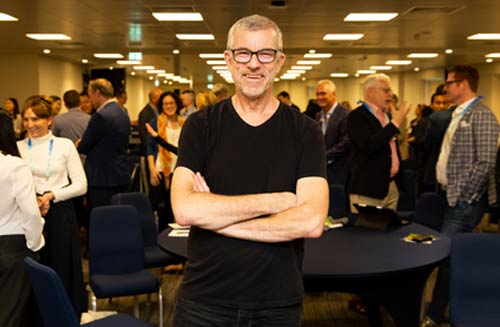
Ah, the joys of pitching. Your entire masterplan squeezed into a few sentences, a room of powerful strangers with your future in their hands, and mere seconds to impress them. Who doesn’t love a quick dip in a shark tank?
Quite a lot of people, unfortunately. Luckily for them, pitching coach David Beckett is here to help.
Beckett has spent decades mastering the art of public speaking. He first honed his skills through over 1,000 corporate presentations across 16 years at Canon, before switching to the crisper craft of startup pitches.
In 2013, Beckett founded Best3Minutes, which provides in-person and online training in his method. The techniques have now been taught to more than 1,800 startups and scaleups, which have gone on to raise over €420 million between them.
“My goal is not to tell people what to say,” Beckett tells TNW. “My goal is to give them a framework to find their story, practice it, and make it land with their audience.”
At TNW València on March 30, Beckett will provide his latest pitching workshop. Ahead of the session, he shared some of his top tips for startups.
1. Tune in to your audience
Your pitch needs to align with the desires of your audience. Who are they? What’s important to them? How can you impress them?
Imagine you’ve created a crypto-powered parking app. You could expound on the benefits of storing driver data on a distributed ledger, but few people enjoy torture by blockchain.
”When we work on something day in, day out, we often just want to tell people about what we’ve built — but the audience might not care at all,” says Beckett.
“The execution comes from your product, process, and team.
A more powerful pitch will illustrate a real-world impact. You could say (if it’s true, of course) that people waste 20 minutes every day finding a parking space. With the click of a button, your app cuts the time down to 60 seconds.
That example, however, may not enthral everyone. To make your audience do what you want, you need to know who they are.
2. Focus on the problem and solution
Your pitch needs to focus on pain and gain. This should fit into a simple statement that reveals what you can do for customers.
A human problem makes the issues more relatable. What does the pain result in? How big is the problem? Will people pay to solve it? How have you validated that? Investors want these answers.
“Things that especially trigger them are the size of opportunity and execution against that opportunity,” says Beckett. “And the execution part is product, progress, and team.”
3. Establish a clear objective
A successful pitch results in action. The ultimate target is often a set investment, but startups normally need to take a different first step. It could be a follow-up meeting, an introduction, or scanning a QR code that shows the audience further information. The most important outcome is maintaining a connection.

Whatever your objective, make it clear and memorable. You may only have a few minutes to convince your audience to take action.
“Of course, you can’t communicate all the details in that time, but that’s not really the goal,” says Beckett. “The goal of the pitch is getting to the next step.”
4. Use post-it notes to organise your thoughts
Once you’ve got an objective, you need a strategy to reach it. Beckett advises using post-it notes to get the ideas out of your head and into a storyline. To shrink the prep time, he also recommends downloading his Pitch Canvas, a free storytelling tool for structuring your pitch.
“It’s really difficult to deliver the pitch with certainty and passion when you haven’t got the story straight,” he says. “Once you’ve got the story straight, you can start going into the delivery part.”
5. Demonstrate your value
Investors want to see evidence that you can execute your plan. If you’ve got customer traction, explain who’s using the product. If you’ve got a demo, show the product working. When time is short, a screenshot can suffice.
“If you can convince them that it’s a business, not a concept, they’ll think differently about it,” says Beckett. “And what convinces people it’s a business, not a concept, is a working product and customers.”
“Once they say things out loud, they often find what they wrote is too technical.
If your product is still a concept, there are other ways to demonstrate your value. One is showing you have the passion to put in the hours. Another is any funding that you’ve already raised.
“There’s a couple of things that come from that. Firstly, people trust you. Secondly, you’ve been through a due diligence process, so they’re unlikely to get surprises.”
6. Captivate them with your opening
You need to quickly gain the interest of your audience. Investors can see up to 1,000 pitches a year and are always short on time. To capture their attention, your opening has to stand out.
If it doesn’t land, says Beckett, their support “is almost certainly going to be a no-go.”
7. Polish the delivery
Once you have a prototype pitch, it’s time to verbalise it. Practice saying it out loud in front of an audience, and use their feedback to fine-tune your delivery. You can then take a step back and reassess the clarity, focus, and rhythm.
“Once people start saying things out loud, they often find out what they wrote is quite technical, and want to make it more direct,” says Beckett.

Your delivery should emphasise the words that matter. Beckett uses the example of a fictional delivery startup. In a pitch, the founder plans to say, “We deliver a sustainable and energy-boosting doughnut to meetings near you.”
If their focus is proximity, they can stress that doughnuts are delivered “to a meeting NEAR YOU.” If their USP is sustainability, they can emphasise that “we deliver a SUSTAINABLE and energy-boosting doughnut.” If they’re selling the energy effects, they can accentuate that it’s a “SUSTAINABLE and energy-boosting doughnut.”
Your delivery must also connect on a human level — a crucial element of pitching. Just one moment that shows your passion for the project can make an enormous difference.
8. Manage your time with a script
In discussions about public speaking, the relative merits of spontaneity and planning are endlessly debated. For Beckett, the best balance depends on your allotted time.
In a half-hour corporate presentation, you might only need to memorise the opening. In a short pitch, however, you’ll probably need a full script.
“For a three-minute pitch, the pressure is too much for most people’s brains to manage,” says Beckett. “If they don’t make a proper plan, they forget to say the things they really want to say, and spend too much time on things that are not so important.”
9. Time to perfection
Beckett has done extensive research on our listening and speaking capacities. He’s concluded that you should pitch a maximum of 150 words per minute.
“If you speak faster than that, people can’t follow,” he says. “It’s best to speak a bit slower so that people can process it. Get a bit of air around the key messages, but with enough energy and speed.”
Those 150 words will fit into approximately nine sentences. A three-minute pitch, therefore, will typically comprise around 27 sentences. If you’re struggling to structure your story, those rough boundaries can help allocate the time.
And if that doesn’t quell the anxieties about being judged in a few minutes, just remember: it will all be over in a few minutes.
David Beckett will be speaking at TNW València, which takes place at the end of March. If you want to experience the event, we’ve got something special for our loyal readers. Use the promo code TNWVAL30 and get a 30% discount on your conference business pass for TNW València.
Get the TNW newsletter
Get the most important tech news in your inbox each week.




